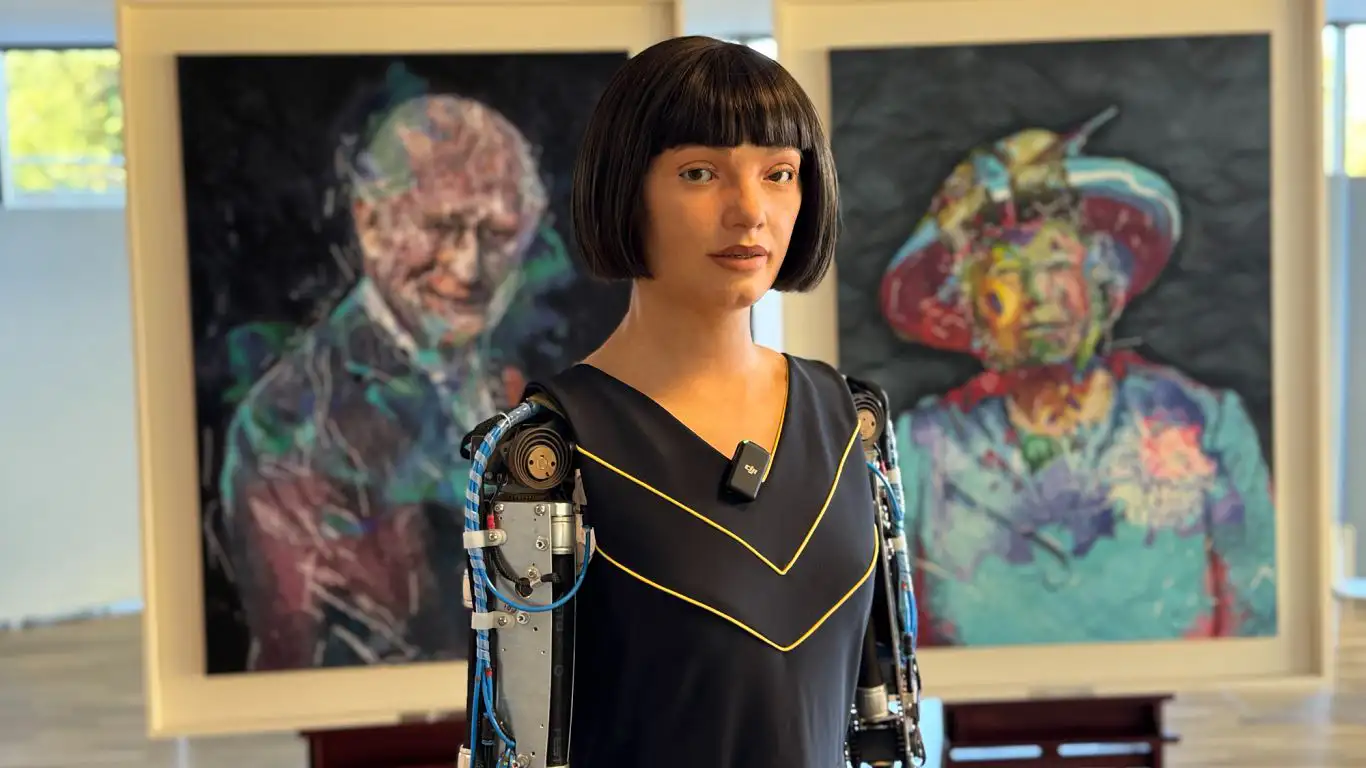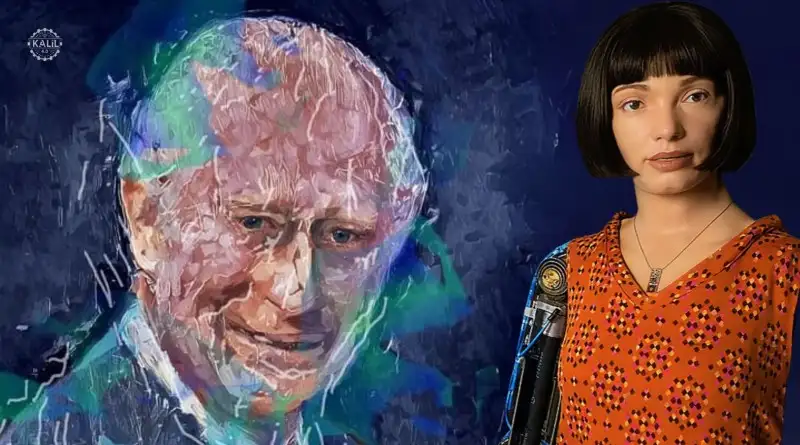AI Robot Paints Portrait of King Charles: A Fusion of Art and Technology
Introduction
In a groundbreaking blend of tradition and innovation, Ai-Da, the world’s first ultra-realistic humanoid robot artist, has unveiled a striking portrait of King Charles III titled Algorithm King. Revealed at the United Nations’ AI for Good Summit in Geneva on July 17, 2025, this artwork marks a historic moment in the intersection of artificial intelligence (AI) and creative expression. This article explores the significance of Ai-Da’s creation, its technical and cultural implications, and its relevance to global and Indian audiences, offering unique insights into how AI is reshaping the art world.
Ai-Da: The Humanoid Artist Redefining Creativity
Ai-Da, itself named after the pioneering mathematician of the 19th century, Ada Lovelace, was conceived by British gallerist Aidan Meller in 2019 and developed by a team of engineers and programmers at Engineered Arts in Cornwall, UK, and Oxford and Birmingham university researchers. In contrast to normal artists, Ai-Da does her oil paintings, drawings, and sculptures by a combination of high-resolution cameras in her eyes, sophisticated AI algorithms, and a robotic arm. It is also possible to have a dialogue with her using an in-built language model, which makes her a multipotential risk management guru.
Recently, she deleted her Algorithm King after last year’s Algorithm Queen on the occasion of the Platinum Jubilee in a portrait of Queen Elizabeth II. The two unpainted portraits, for which neither of the monarchs posed, were exhibited alongside each other at the Geneva summit, with the world debating how AI affects the art industry. Her growing influence in the art market is demonstrated by her ability to create a painting of Alan Turing that sold in 2024 at Sotheby’s for the amount of 1.08 million dollars.
The Making of Algorithm King
The making of the portrait of King Charles III is done by a very advanced procedure. The monarch did not sit on the painting, and instead various images of the monarch were captured and processed using the eye-mounted cameras on Ai-Da. These images were fed into her AI algorithms that made choices involving form, tone,, and texture,, and her robotic arm precisely applied oil paint on canvas. The outcome is a bright work with the flashes of blue, green, and crimson, which refers to the environmental activities of King Charles, and added by motioning lines filled with dynamism and modernity.
Ai-Da said at the unveiling, “It is not simply an artistic activity,, but it is a political statement that I am making because I am presenting a portrait of His Majesty King Charles III to convey the changing nature of artificial intelligence in our world and to comment upon the way we are changing and being shaped by this influence of artificial intelligence upon the culture of our society.” This was similarly expressed by Simon Manley, UK Ambassador to the World Trade Organisation and UN in Geneva,, who stated that Ai-Da is a cultural icebreaker representing British innovation.
Unique Insights: Art, Technology, and Ethics
Redefining Authorship and Creativity
The work by Ai-Da rescinds normative ideas of artistry. She does not employ an emotional intuition, as human artists do, do, but an algorithmical interpretation. Dissenters would say the technique of her painting is technically excellent but does not have the expression of a manmade picture. The Telegraphraph review described Algorithm King as insipid and derivative and one that places likeness over originality. But Aidan Meller responds that Ai-Da is not a concept made to duplicate human creativity but to raise ethical dilemmas and questions about whether robots have the right to create. Such a discussion is especially applicable in India, where such art forms as Madhubani and Warli are connected to cultural and emotional stories.

The Indian Context: AI and Cultural Innovation
India, the country of great artistic traditions, with the fast-developing segment of AI, is in a very special position. The AI market in the country is estimated to go up to 17 billion dollars in 2027, following initiatives such as the India AI Mission. The work that Ai-Da created might stimulate the artists and technologists in India to pursue art that is informed by AI and could combine older methods and tools. As an example, classical forms of art in India can be digitised and deciphered with the help of AI and presented to people worldwide, keeping their originality intact. Such innovations might be spearheaded by an institution such as IIT Madras or startups in Bengaluru,, which will develop platforms to create AI-assisted art.
Nevertheless, when AI is used in art, there seem to be questions of cultural purity. Indian artists might be scared of the possibilities of the AI-created works shadowing traditional craftsmanship, especially in the market where people rely on handcrafted art as a profession. The preservation of culture and the further development of technologies will be important.
Public Reactions and Ethical Debates
The announcement of Algorithm King caused ambivalent emotions on social networks. Others wondered at its technical feat, and one Instagram user said, “These are really awesome-looking.” Perhaps, I ought to take up painting. Very inspirational!” The rest of the people felt apprehensive, and some of the remarks included, AI is not only taking the places of professions but also hobbies and skills that were only held by humans. These are sentiments that exemplify worldwide fear of AI intruding into the creative territories, and these fears are applicable in India,, where millions of others work in the creative sectors.
Questions of authorship also come under ethics. Who is the creator then when the algorithms Ai-Da programs are designed by a human? This is the concern that repeats in the tech-savvy cities of India,, such as Hyderabad,, where the field of AI ethics is raising concern. Clear principles that govern AI in creative matters will play an important role in the trustworthiness of the art world.
Broader Implications: AI in the Creative Industries
The portrait by Ai-Da helps to emphasise the idea that AI can change creativity. In 2022, she took part in a debate at the UK House of Lords about the future of creativity, and her work has acquired the most luxurious venues, such as Tate Modern and the Pyramids of Giza. Her sale at Sotheby’s, which saw a painting clinch a huge price of $1.08 million, is also an indication that there is an emerging market for art generated by AI.
In India, AI will transform such areas as animation, film, and design. In a case such as a studio in Mumbai, AI could be used in order to facilitate production of visual effects, hence cutting cost and time. Nevertheless, large computational demands of AI systems such as those of Ai-Da, which might imply high energy and infrastructure, are impediments to maintaining their widespread use in resource-scarce environments.
The Global and Local Impact
All over the world, the work of Ai-Da at the UN summit indicates the role of AI, which creates some conversation around the social effect of technology. In the case of India, it is a chance to become a leader in the integration of n cultural innovations. Schools might incorporate the AI art into the school curriculum and ask students to work with its artistic and moral implications. In the meantime, policymakers should take care of the equal availability of AI tools so that the digital gap does not arise in the domain of creation.
Conclusion
The Algorithm King by Ai-Da is not just a portrait; it is the evidence of the revolutionary power of AI in the cultural world. In portraying King Charles III, Ai-Da has engaged the world in a dialogue about creativity, technology, and ethics and touched people across the globe, ranging from the streets of London to New Delhi. In the case of India, the milestone will present an opportunity to unite its artistic heritage and the latest innovations as long as it attends to the upcoming ethical and cultural dilemmas. With the world in awe of amazement and scepticism, AI keeps on reinventing the notion of creativity as they observe intently to see how this hybrid semi-human, semi-Turing AI will pan out as pre-destined to dictate the future.
Disclaimer
The information presented in this blog is derived from publicly available sources for general use, including any cited references. While we strive to mention credible sources whenever possible,
Web Techneeq – Web Design Agency in Mumbai does not guarantee the accuracy of the information provided in any way. This article is intended solely for general informational purposes. It should be understood that it does not constitute legal advice and does not aim to serve as such. If any individual(s) make decisions based on the information in this article without verifying the facts, we explicitly reject any liability that may arise as a result. We recommend that readers seek separate guidance regarding any specific information provided here.

